|
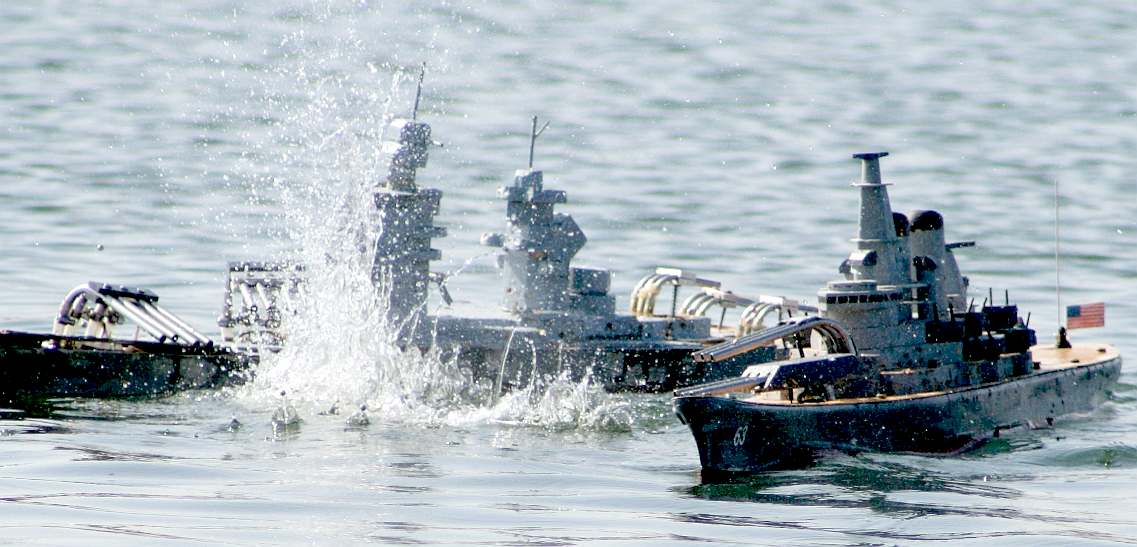
Richelieu and Missouri battle it out in a scale model simulation,
with some serious firepower being brought to bear using pneumatic ball
bearing firing cannons.
NAVAL WARGAMING
Naval wargaming is a branch of the wider hobby of miniature wargaming. Generally less popular than wargames set on land, naval wargaming nevertheless enjoys a degree of support around the world. Both historical and fantasy
rule-sets are available.
Model ships have long been used for wargaming, but it was the introduction of elaborate rules in the early 20th century that made the hobby more popular. Small miniature ships, often in 1:1200 scale and 1:1250 scale, were
maneuvered on large playing surfaces to recreate historical battles. These models were basic representations of ship types, with enough detail to make them
recognizable. Firms such as Bassett-Lowke marketed these to the public in England, along with more detailed versions that appealed to collectors. Prior to World War II, the
German company Wiking became a leader in the field, but the war ended its dominance.
After World War
II, several manufacturers started business in Germany, which remains a major centre of production to this day. Other companies started in
Britain and the
United States as well, first centering on the wargamer, but as time went by and models became both more detailed and costly, marketing to the collector. There has also been a diversification in scales. Plastic kits in 1/600 and 1/700 became widely available. In the UK Skytrex and Navwar pioneered the "micro scale" with extensive ranges of ships from pre-dreadnought ironclads to modern vessels in 1/3000. In the US CinC and GHQ followed with slightly larger and more detailed models in 1/2400. In recent years Hallmark have moved the scale down to 1/6000.
A separate branch of naval wargaming uses radio control ships capable of firing BB ammo from
CO2 powered cannons, with the aim of sinking opposing ships, whose hulls are made of thin balsa wood.

Oversized model pirate ships for the Pirates Constructible Strategy Game, at
Gen Con Indy 2007. Gen Con is the largest tabletop-game convention in North America by either attendance or number of events. It features traditional pen-and-paper, board, and card games, including role-playing games, miniatures
wargames, live action role-playing games, collectible card games, and strategy games. Gen Con also features computer games. Attendees engage in a variety of tournament and interactive game sessions. In 2014, Gen Con had over 56,600 unique attendees, making it one of the largest conventions in North America.
Established in 1968 as a wargames convention by Gary Gygax, who later co-created Dungeons & Dragons, Gen Con was first held in Lake Geneva, Wisconsin. The convention's location moved between various sites in Wisconsin from 1972 to 1984 before becoming fixed in Milwaukee, Wisconsin in 1985, where it remained until moving to its present location, Indianapolis, Indiana in 2003. Other Gen Con conventions have been held sporadically in various locations around the United States, as well as internationally.
In 1976, Gen Con became the property of TSR, Inc., the gaming company co-founded by
Gygax. TSR (and Gen Con) were acquired by Wizards of the Coast in 1997, which was subsequently acquired by Hasbro.
Hasbro then sold Gen Con to the former CEO of Wizards of the Coast, Peter
Adkison, in 2002. Gen Con spent a short time under Chapter 11 bankruptcy protection, due to a lawsuit brought against them by
Lucasfilm in 2008. The organization emerged from bankruptcy protection a year later, while still holding its regularly scheduled
events - a battle of a different kind. http://en.wikipedia.org/wiki/Gen_Con
RULES OVERVIEW
As with other arms of the wargaming hobby, rules can vary greatly in complexity. Commercially available historical
rule-sets cover practically every era of naval warfare from the ancient and medieval ships through the fleets of the Age of Sail, the ironclad an battleship eras to the modern era. Models of most common types of ships are available, but in many cases wargamers have to source their own models, either by conversion or scratch building, especially where more esoteric periods or scales are in use.
The ancient Romans staged what were probably the first naval "wargames", with mock sea battles acted out in
Rome's
Coliseum, specially flooded for the occasion. (These Naumachiae later provided the inspiration for the title of Rod Langton's ancient naval rules.)
Popular naval wargaming began with the inclusion of wargaming rules in early editions of Jane's Fighting Ships by Fred T. Jane. Classifications of ships' armour and armament in Janes' were used directly within the rules. Incarnations of the rules are still in use today.
A later proponent of popular naval wargaming was American author Fletcher Pratt. As well as publishing his rules Pratt staged large public games in ballrooms and other large meeting rooms, the events being almost as much a social event as a wargaming meeting. As with Janes' rules various incarnations and revisions of the Fletcher Pratt rule system are still in use today.
The Age of Sail rules for the 1972 Don't Give Up The Ship! call for pencil and paper, six-sided dice, rulers and protractors, and model ships, ideally of 1:1200 scale. Single ship engagements can be played on a tabletop, but fleet battles require more space. The rules are elaborate and cover morale, sinking, fires, broken masts, and boarding.
Wind speed and direction are determined by a roll of the dice; a protractor is used to measure the angle between the wind and ship directions and hence determine ship speed. The protractor is also used to determine which cannon can fire on an enemy ship, as well as the damage caused and the chance of hitting at short range (4") and long range (16"). The conclusion of the rulebook provides the statistics necessary to re-enact historical encounters such as during the War of 1812. The second edition added 4 pages of simplified rules for battles between fleets.
One of the most popular sets of rules available at present is General Quarters, written by Lonnie Gill. Quick and easy to play, they have established themselves over the years as one of the leading sets of
World War I and II era rules. General Quarters 1 and 2 feature a slightly abstract combat system and ship definition system reminiscent of naval board wargames. However, this approach led to a fast-playing system that was the root of its popularity (probably coupled to an extensive array of supporting information and ship statistics). GQ1 and 2 have recently been replaced by a less abstract version, GQ3 which covers WW2; a WW1 version entitled Fleet Action Imminent was released in January 2008.
Followers of naval wargaming tend to concentrate on historical settings. However, there is a smaller but nonetheless active arm of the hobby that covers fantasy and science fiction naval warfare. The now out-of-print fantasy game Man O' War, set in the realm of Warhammer Fantasy, dealt with sea battles where each player typically controlled half a dozen to a dozen model ships. Each model had a corresponding template to record damage, crew levels, and outbreaks of fire, among other bookkeeping activities. In this regard, the game mechanics proved some limiting factors. Ships were split into three categories: Ships of the Line, Men O'War and "Independents". The Bretonnian fleet was modelled on ships of the 17th century, while the Empire tended more towards the look of earlier time, with some ships that carried single large cannon or mortars. Dwarf ships were steam powered ironclads, and they also had submarines and balloons. High Elf ships were fast maneuverable sail powered ships, while Dark Elves mainly used great sea creatures as the basis for their "ships".
Land-based miniature wargames have also been adapted to naval wargaming. All at Sea, for example, is an adaptation of The Lord of the Rings Strategy Battle Game rules for naval conflicts. The game's mechanics centred on boarding parties, with options for ramming actions and light artillery in the form of ballistae and other siege engines. As such, the ship's scale ratio corresponds to the 25 mm scale miniatures used by The Lord of the Rings. Model ships are built by hobbyists, just as normal miniature terrain, such as "great ships" of Pelargir, cogs of Dol Amroth and Corsairs of Umbar galleys. Elsewhere successful adaptations of the DBA and Fire and Fury land warfare rules have been made to ancient and Renaissance naval battles at the fleet action level (where naval battles shared many characteristics of their land based equivalents).
An unusual source of recent historical naval wargaming rules has been the adaptation of science fiction starship combat rules (the reverse is also true, as sci-fi tends to treat starships as being an evolution of "wet navy" shipping). An example of this approach to rule development is
Victory at Sea from Mongoose Publishing. This is a simple, "entry level" set of rules developed from Mongoose's A Call to Arms sci-fi rules. Victory at Sea has also spawned a number of period variants including Ironclad and Age of Sail, and a World War I variant set called "Age of dreadnoughts" has also been published. Elsewhere a variant of the Full Thrust science fiction starship combat rules exists that covers age of sail battles. Another example, Battlefleet Gothic (BFG), is based from the Warhammer 40,000 land battle game, both developed by Games Workshop. Every major army in Warhammer 40,000 has its representative fleet in BFG, as it is known colloquially.
Classic space navy battle games such as Star
Trek: Starship Tactical Combat Simulator corporation or Star
Wars: Star Warriors have been heavily influenced by naval terminology.
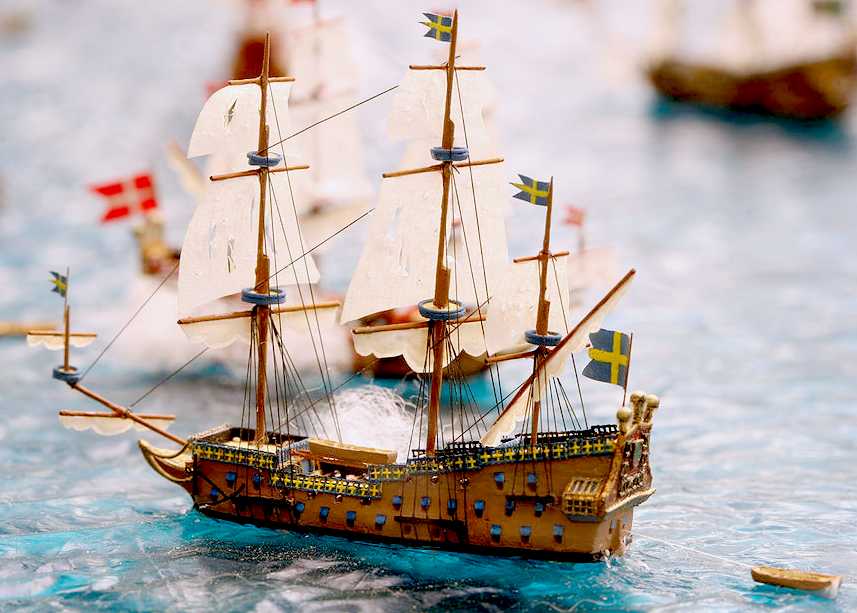
MODEL SCALES
In contrast to land wargaming, naval wargaming almost exclusively uses ratios to express the scale of the models. Popular scales include:
*
1:6000, 1:4800, 1:3000, 1:2400 - popular for use in games of the pre-Dreadnought era and later, although some notable ranges in earlier periods are available.
*
1:1800 - A growing intermediate scale, made popular by games such as Axis and Allies: War at Sea that use a "trading card" format. While still less common than smaller and larger scales, the simpler dynamics of "casual" wargaming makes this an increasingly common introductory scale.
*
1:1200, 1:1250 - the popular "collectors" scale, models from practically every era and nationality are available in this scale.
*
1:900 - an unusual scale, used for ancient naval games.
*
1:600, 1:700 - generally used for coastal forces gaming set in World War I, World War II or post war periods. Due to the availability of plastic kits in this scale, some naval wargamers use these scales to play "in the grand manner" for battleship encounters, often playing on areas measured in yards rather than feet. This is also an extremely popular scale for American Civil War riverine and other ironclad era actions.
*
1:450 - another unusual scale, used for pirate and small Age of Sail actions (e.g. Peter Pig's "Pieces of Eight" range).
*
1:400, 1:300, 1:285 - some coastal models are available in these scales. Often used for riverine actions involving close liaison with land forces in similar scales.
*
10mm or 1:160 - a newer scale for "collectible" American Civil War naval gaming. Often used for actions involving close liaison with land forces in 10 mm.
Notable exceptions to the "ratio" rule are the use of 15 mm to 25 mm games that
emphasize boarding actions, and thus make use of figure ranges in those scales.
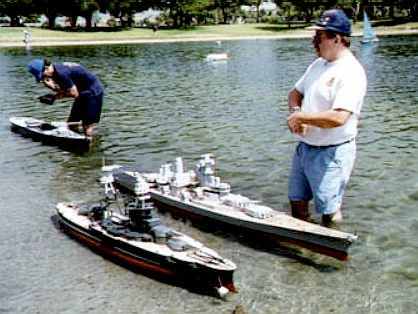
Preparing
for a WWII naval battle in San Diego
RADIO CONTROL COMBAT
Rather than simply acting out battles through the use of representative static models, in model warship combat, radio control ships (usually used in ponds) are constructed and outfitted with BB cannons capable of damaging and sinking other vessels. The ships are designed to be realistically sunk, and all clubs have very stringent rules requiring ships not to be built with hulls stronger than is appropriate, typically specifying a thickness of the balsa wood hulls as well as a test of penetrability. To reduce the chance of spectator injuries, and to prevent a vessel from having an unfair advantage, the propellant gas used in the cannons is limited in pressure, and may be tested by the judges, again disqualifying a ship if it is too high.
For historic replicas, relative properties of the real ship are maintained, such as the number of guns, maximum speed, and so forth. Speed tests are often performed, and any ship traveling faster than the appropriate scale speed may be disqualified or ordered to maintain a slower speed. An inappropriately high top speed gives a ship an unfair advantage, and is frowned upon by other members. 1/144 scale is the most common scale, although others do exist.
Some events try to recreate historic events, while others create original scenarios, such as all-out war, a subset of ships defending a port against an attacking enemy, protection of a group of unarmed merchant vessels, or any other scenario the club members decide would be fun. Even in recreations of historic battles, the sequence of events and outcome of the engagements are decided by the actions and luck of the operators, and often do not have much resemblance of the historical events.
Depending on the rules, a ship may be allowed to surrender and receive safe passage back to shore where it is removed from play, or other ships may fire on it until it sinks. Ships are designed to tolerate sinking such that a sunken ship need only be retrieved after the battle is over, minor repairs executed, fresh batteries installed, and returned to the water for the next round. Many ships also contain bilge pumps, of a maximum capacity specified by the rules of a specific club for the type of ship, to allow them to sustain minor damage without immediately sinking.
In some formats, events are scored by the final results, such as which side has more remaining ships (or survives longest) in a two team game, while others are scored on a point systems, with hits and sinkings assigned differing point values.
WEAPONS
FOR RADIO CONTROL COMBAT - MECHANICAL SYSTEMS
While many models use a combination of switches and/or relays physically actuated by servos to control the propulsion system, most newer models now use either Electronic Speed Control units or solid-state switching boards such as those found in
Robot combat, greatly reducing the complexity of the wiring of the propulsion system as well as overall complexity of design. Propulsion is achieved through the use of electric motors coupled to shafts passing through stuffing tubes driving semi-scale propellers. All active mechanical systems are required to be operated via electrical or pneumatic means. Banned are any and all mechanisms relying upon chemical combustion which could contaminate the water with fuels, oils, and other biologically toxic chemicals.
WEAPONS
FOR RADIO CONTROL COMBAT - WEAPONS SYSTEMS
Cannons use steel balls ranging from .177" to .25" in diameter as projectiles, and typically CO2 or compressed air is used as the working gas for propellant. As of 2009, a small handful of small Big Gun ships were equipped with cannons powered by compression springs. In Big Gun combat, club rules frequently include provisions for the arming of
torpedoes, represented through the use of fixed cannon firing 0.25" diameter projectiles. Although individuals have attempted to construct self-propelled 0.25" diameter torpedoes, they have yet to be formally documented or demonstrated in use. Additionally, vendors have demonstrated working prototypes of weapons control systems suitable for Big Gun combat to enable multiple turrets on a single vessel to be coordinated as a single weapons battery to produce converging weapons fire at a given vector and range from the vessel so equipped. Pyrotechnics are specifically
(prohibited from use at public events) for weapons to protect the safety of people and
animals in addition to preventing environmental contamination.
Thank heavens there are no such rules during Bonfire
Night celebrations, when the larger and more elaborate the display,
the better.
Radio controlled model warships are fully workable, with small electric motors or
servo-operated
sails for propulsion, working steering systems actuated typically using servos, and are generally armed with self-reloading pneumatic cannons.
The models cannot be purchased as many scale models can, from a company, with everything in one box. They always include a degree of scratch building. There are, however, several suppliers that sell many of the necessary parts for construction. For example, Strike Models, and Battlers Connection.
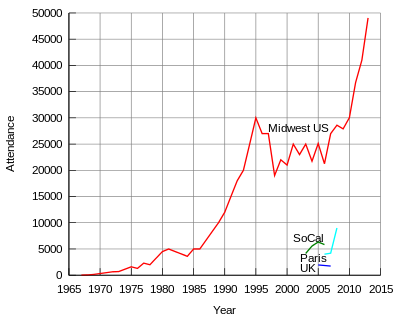
A
graph showing how popular wargaming has become from attendance figures
recorded between 1965 to 2015.
RADIO
CONTROL COMBAT FORMATS
CAMPAIGN - Instead of a single battle, multiple battles or sorties are combined to form a campaign of combat events, sometimes with a preceding battle dictating the available of rearming opportunities afforded to a team in the succeeding battle. A campaign can also consist of multiple objective-oriented battles or team free-for-all battles.
FREE FOR ALL - ROBOT WARS - Typically held in sessions divided by vessel combat units or combat value, during a free-for-all, each captain operates his or her vessel to sink or damage as many of the other vessels on the water as possible while minimizing the damage incurred. It is often played in a "last-man-standing" format where the winning vessel is identified simply as the last to sink or be disabled.
OBJECTIVE - Objective format combat is typically executed in the form of a scenario, requiring that each team accomplish specific objectives to earn points and/or win the scenario. Such combat may involve sides of asymmetrical strength, such as when attempting to simulate a recreation of a historic battle.
TEAM FREE FOR ALL - A common combat format across the different model warship combat formats, team free-for-all involves the division of players present into two teams that are equal based upon a combat strength rubric (i.e. units in Fast Gun or a combination of displacement tonnage and cannon count in Big Gun) which then sortie against each other in accordance with the club's rules and scoring system.
A-Z
LISTING OF NAVAL WARFARE CLUBS & RULES
These are links to a wide variety of naval rules from different authors,
all dedicated to playing out battles at sea.
|
Ancient
Corvus
- Ancient naval rules by Richard Lee .pdf
Naval
Rules - a fantasy set by M C Gianni that is perfectly good for
historical games
Oceanus
Strategoi - Ancient naval rules by Jeff Koppe .pdf
Ram
Speed! - A quick play rule set for Ancient Naval Wargames. Its
meant to be fun and flavourful.
Ramming
Speed - not to be confused with the above; designed for 15mm
figures.
Ram
or Die - The Battle of Salamis - part of the Junior General
series
Rules
for Bert's Trireme Game - Blog-based fast play rules
Trireme
- Ancient naval rules by Andy Watkins
Medieval
Away
with Honour - Wargames Rules for Naval Warfare in the Middle
Ages, by Tony Cullen
Naval
Rules - a fantasy set by M C Gianni that is perfectly good for
historical games
Renaissance, Piracy
Armada
- part of the Junior General series
Barbarossa!
- 16th Century Naval Rules for Galley Warfare by Dave Millward.
Lepanto
- part of the Junior General series
Piracy!
- Rules for ship to ship as well as man to man combat
Spanish
Fury, Sail - A complete game of Warfare at Sea, 1560-1603
(offered by "The Perfect Captain")
The
Battle of Lepanto - The Junior Generals and galley warfare
The
Galleon and The Flame - Spanish Main
in the age of Drake and Hawkins, by Trevor A. Brabyn.
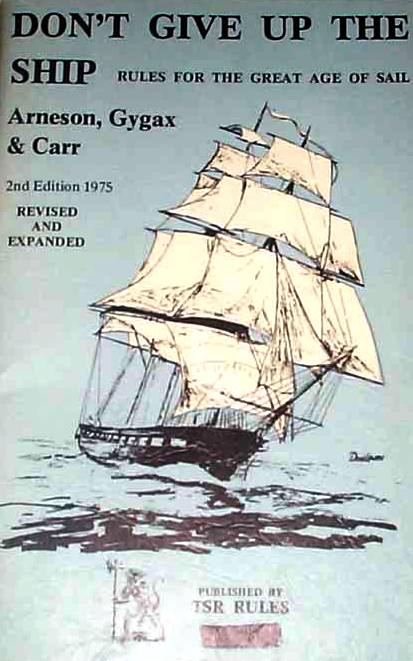
Age of Sail
A
Toda Vela - Spanish language naval rules
Admiralty -
Fighting Sail Warfare, 1750 - 1815
Letter of Marque and
Reprisal - small-scale naval engagements in the 'Age of Sail'
Master
and Commander - rules from Capitan Games
Men
o' War - AoS rules from
Camp Cromwell
,
Australia .pdf
Nelson's
Wars - Fast play rules by Andy Watkins
Quick
and Dirty Napoleonic Naval Wars - Quick, and dirty!
Simple Sails - Quick and simple AoS action .pdf
Shot
and Sail - Small ship actions
The
Immortal Memory - naval wargames rules for Trafalgar
Tough
Men with Iron Balls - Fleet action rules (based on the "Piquet"
rules, which are required to use this variant)
Trafalgar
- part of the Junior General series
We
Have Met the Enemy and They Are Armed with Pennies! - The
Junior Generals and the batle of
Lake Erie
. Innovative rules involving flicking pennies (hence the name!)
Ironclad and American Civil
War Era
American
Civil War Naval Rules - One page naval rules for quick games,
by Jim Brown
Anaconda
- Fast Play Strategic Civil War Blockade Game (Junior Generals
series)
Battle
of Lissa - Fast play rules from the "Junior
Generals" series
Corpen:1889
- Ironclad and pre-dreadnought rules inspired by GDSW's
"Ironclads and Ether Flyers"
"Damn
the Torpedoes!" The Battle of Mobile Bay - part of the
"Junior Generals" series
Iron
and Steam - Victorian / ACW Ironclad rules by Jeff Koppe
Ironclad
Gunboat - a set of quick-moving, hard-hitting rules, best
suited to those who wish to sacrifice a certain amount of realism
for the sake of the game.
Smoke
on the Water - Jason Gorringe's ACW naval rules
Noddy
ACW Rules - by Andy Callan
Predreadnought
Battlefleet 1900
- Rules for the predreadnought era from the War Times Journal
Quickfire -
WTJ Fast Play pre-dreadnought
Steel
Ships and Iron Hearts - Naval rules by Dick
Larsen, used by the Olympic Wargaming league (OWLs).
Togo
- Rules for the Russo Japanese War.
Battle
of Tsushima Strait (1905) - "Monte Carlo on the High
Seas" (Junior Generals series)
WW1
Battlefleet
1915 - WTJ WW1 naval rules (under development)
Coal
and the Kaiser - a game of low to moderate complexity
portraying tactical naval combat in the period from 1904 through
1918
Day
of the Dreadnoughts - The Junior Generals and
Jutland
, 1916
Dreadnought
- Turn of the century naval rules by Andy Watkins
Great
War Naval Rules - Part of GR/D's "Great War" series
.pdf
Ironclad
Draughts - Towards the botonm of the page. Wargame
Developments
Jutland
- part of the Junior General series
Quickfire -
WTJ pre-dread and WW1 rules
Theres
Something Wrong With Our Bloody ships Today - Staines
Wargamers rules for 1/5000 (!) scale gaming
Tojo -
Straightforward
rules, similar to the Surface Action rules, but for naval battles
of the Russo-Japanese War of 1904-05.
WW1
Naval - Steve Burt's WW1 naval rules
WW2
Battle
of Midway - part of the Junior General series
Battle
of the Atlantic - The Junior Generals and the WW2 U Boat
campaign
Brawl
in the Dark - Another in the Junuior Generals series, covering
battles off
Guadalcanal
Coastal
Command - coastal forces actions in WW2
Corpen
18 - WW2 naval rules
Fire
on the Waters - A game of moderate-to-high complexity
portraying tactical surface combat in World War II.
High
Seas Drifter - fast play rules by Ty Beard
Hunters
on the Shoreline - PT Dockyard rules for light forces
Midway
- Historical simulation of the WWII battle of Midway.
Panzer Eight
- a collection of free rules including coastal and
"mainstream" WW2 naval
Sea
Battles - Abstract WWII Naval Strategy Game
Seas
of War - Naval Rules Construction Program
Seekrieg - The SEEKRIEG
site is intended as a resource for naval wargamers who, in this
life, have never had the opportunity to shout "open
fire" from the bridge of a warship as it plunges through a
wind-whipped sea to engage the enemy.
Sea
Wings - a game of aircraft carrier warfare in World War II.
Sink
the Bismarck - part of the Junior General series
Surface
Action - This is a simple, quick play, rule set covering
surface actions in World War II.
Surface
Warship - by Robert Whitfield
The Coral
Sea Campaign - WW2 naval campaign rules with impressively
(over) large fonts!
Tonnage
War - a card game that simulates a World War battle between an
Allied convoy and German submarines.
Tora,
Tora, Tora - The Junior Generals and
Pearl Harbor
WW2
Naval Rules - by "Faramir of Borg"
WW2
Ships - Something a bit different (in wood!!)
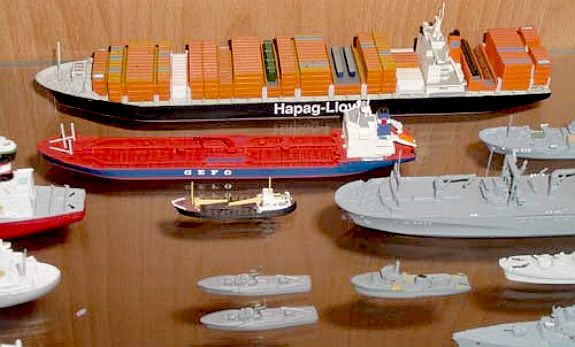
A
selection of die cast scale models used in wargaming
Modern
Cold
War Naval Battles - the former "Modern Naval Battles card
based rules
Cod
War - my own rules for these most unusual actions!
EmCon
C - Modern naval rules at the operational level
SF/F
Aquazone
- The Game of
Deep
Sea
Exploration & Combat !
Stingray,
Stingray! - Anything can happen in the next half hour using
these rules for subaquatic mayhem in the Gerry Anderson universe!
Computer
Games
2
by 3 Games
Avalon
Hill
Battlefront
Eidos
Matrix
Games
Microsoft
Games
Raider
Operations
Shrapnel
Games
Strategy
First
Strategy
Gaming Online
|


JOHN
DRAIN'S TORPEDOES - These superb model torpedoes were made with gearbox
(single motor) and dual electric motor contra-rotating propeller versions.
The dual motor version is shown here. There is no explosive charge built into
the design, an obvious next step. Imagine what damage a 4/10 cartridge would inflict on even a
large model battleship. These fish go live once moved away (launched) from
a magnetic reed switch, at the same time arming the machine, in this case
simply switching on the motor circuits. After than we need steering and
target acquisition. Now there's a challenge for all you budding electronic
engineers. Probably the simplest method will be aiming at a certain audio
frequency. You'll need stereoscopic hydrophones derived from piezo
electric microphones as the sensing head, linked to steering coils. These
are not expensive. Picaxe
or similar value microprocessors are ideal to process information of the
environment and locate a moving target (suggest home in on electric drive
motors). Or? Let us know how you get on. Maplins produce a robot kit
called the Escape for about £16, that provides more or less the same
functions, except that the sensors are infrared (x3) and the robot (also
dual motor) is designed not to hit walls, the reverse of targeting.
Avoiding something is just as challenging as hitting something.

The NWS is
a voluntary organisation based in the UK, that is not commercially
motivated. As such the decisions about the society's future rest with the
members and elected committee.
Members of The Naval Wargames Society are interested in all forms and scales of maritime wargaming. The society was formed on December 4th 1965, originally
by Phil Dunn and Colin Bishop. Society games were first held in Chessington and in later years
moved to North Holmwood.
Other prominent members in the early days were John Hammond and Tony Anderson, founders of Skytrex and Navwar. Then in 1994 the NWS and the "Battleship club" merged (also started by Phil Dunn). A return to wargaming in 1993 by Phil saw the NWS expand, with regional groups being established in Kent(Ashford), Thames Valley(Mortimer), Wessex(Trowbridge) and Surrey(North Holmwood).
The society's goal is to promote naval wargaming and to act as a forum for the exchange of information. As a means to this end it produces two publications:
1. "Battlefleet" - a journal published approximately once a quarter,
2. "All Guns Blazing" - a monthly news letter,
The society encourages their members to write articles about wargaming, and maritme history. NWS also encourages member participation by holding multiplayer naval wargames. As well as these games, the Regional groups of the society sometimes represent NWS at gaming conventions, an example of this is the Lissa game run by the North Hull Wargames group.
NAVAL
WARGAMES JUNE 2014 WEEKEND EVENT
The Naval Wargames Society and the Explosion Museum of Naval Firepower
held the third weekend of naval wargaming at the museum in Gosport over the weekend of June 21st and 22nd 2014. The emphasis of the event
was on games and getting together, following a superb selection the previous year.
There was plenty of space and space was available for upwards of ten tables. Space
was available in the museum grounds for camping over the weekend. Admission to the museum for the weekend
was free for those running games.
The aim of the event was to provide a forum where naval (and other) gamers can come together to run and/or play in each others' games.
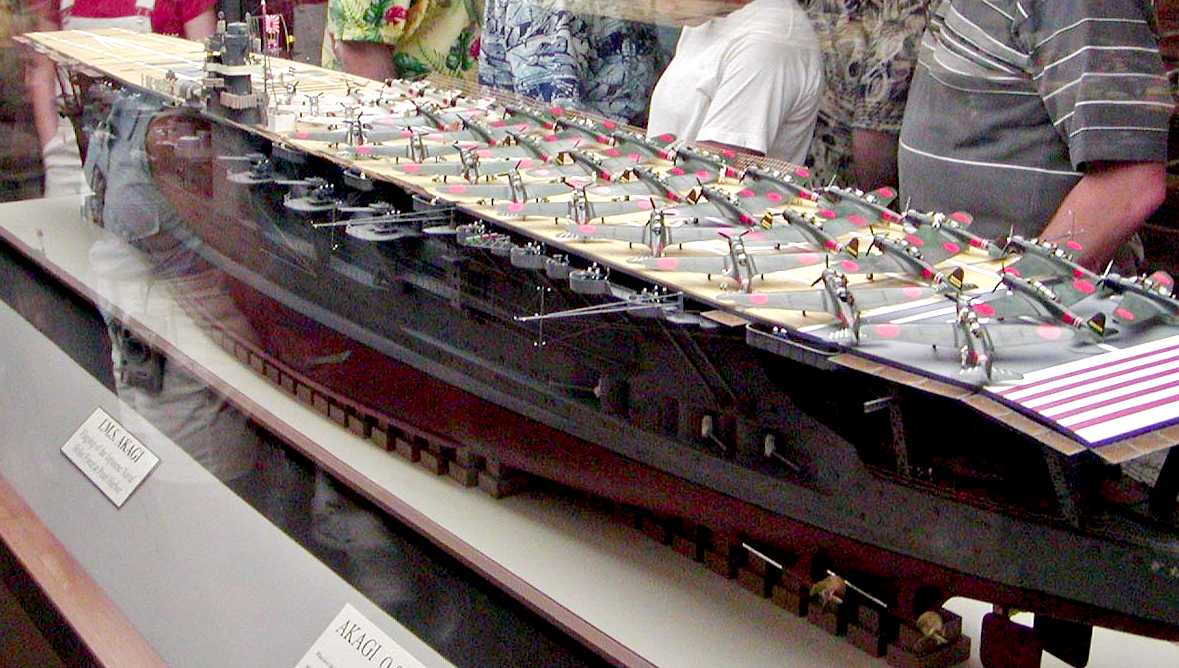
Model
of the Japanese Navy's IJN Akagi aircraft carrier from WW2, on display at a
museum in Pearl
Harbour. Note that there are around fifty Zero aircraft on the deck. The
modeler must have had the patience of a saint. During the second world war,
aircraft became an excellent torpedo delivery method. Zeros had large bombs
attached that could not be released, condemning the pilot to death - as he
became a guided missile. Cruise
missiles and SAMS
have rather changed the way naval battles are fought.
EXPLOSION
MUSEUM OF NAVAL FIREPOWER
Heritage Way
Priddy's Hard
Gosport
Hampshire
PO12 4LE
United Kingdom
Telephone: 023 9250 5600
Fax: 023 9250 5605
Mobile: 077 8741 5382
Web: http://www.explosion.org.uk/
JOIN
THE NAVAL WARGAMES SOCIETY - CLUB CONTACT DETAILS
Chairman: Stuart Barnes Watson
stuart_barnes_watson@hotmail.com
Treasurer, Membership: Simon Stokes
SimonJohnStokes@aol.com
"Battlefleet" Editor : Jeff Chorney
chorney.jeff@gmail.com
"All Guns Blazing" Editor: Norman Bell
normanpivc@gmail.com
Subscription requests, with remittance should be sent to Simon Stokes, at
the address below. Cheques should made payable to "Naval Wargames Society" and should be in Sterling.
Or pay via Paypal.
Simon Stokes
29 Keel Way,
Oxley Park,
Milton Keynes
MK4 4TZ
REGIONAL
GROUPS
Currently there are six such groups located in the following areas;
•
NWS Northern Fleet - Falkirk East Central Scotland
Kenny Thomson, 1 Excise Lane, Kincardine, Fife, FK10 4LW
e-mail: kenny@falkirkwargamesclub.com
Website:
http://www.falkirkwargamesclub.com
Falkirk Wargames Club meets each Monday night at 7pm with a variety of games running each evening. Naval games are popular with 2 or 3 run
a month. Campaign games sometimes feature in their monthly weekend sessions. Games tend to be organised week to week making a 3-month forecast
unrealistic. Get in touch if you'd like to come along.
Popular periods - Modern (Shipwreck), WW1 and 2 (GQ), WW2 Coastal (Action Stations), and Pre-dreadnought (P Dunn's rules)
•
Kent - Andrew Finch AandAGames@compuserve.com
•
North Hampshire – Jeff Crane
NWS North Hants [Every 3rd Sunday]
Jeff Crane 21 Taverner Close, Oakridge, Basingstoke, Hants, 01256 427906
e-mail: gf.crane@ntlworld.com
• Surrey & Sussex - Dave Sharp davshrp@aol.com
• Wessex - Peter Colbeck peter.colbeck@mbda.co.uk
•
The Sixth Battle Squadron (United States) - Bill Madison BillM@navalwargamessociety.org
SCENARIOS
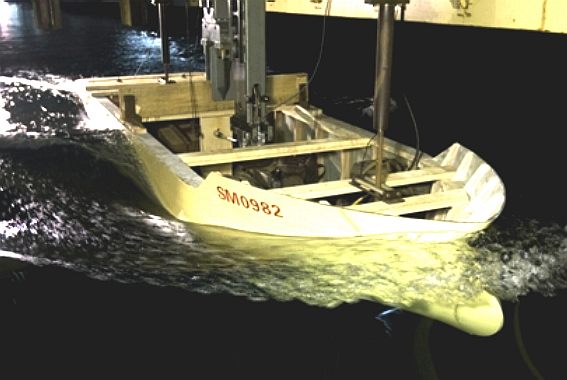
The
'Emerald' bulk carrier scale model hull undergoing tow tank tests.
Just as with wargaming, models are a practical way of proving and developing
a concept, without having to build a full size ship.
TRADERS and DISCOUNTS
The following traders kindly offer discounts to all NWS members as detailed below. Please help them and us by always quoting your membership number when ordering. Thank you.
A&A GAME ENGINEERING
20 Shrublands Court, Mill Crescent, Tonbridge, Kent, TN9 1PH
01732-770811
Wide range of rules
10% discount
http://www.aandagames.co.uk
CHILTERN MINIATURES
60 Elsenham Street, London, SW18 5NT
020 8874 1838
1:2400 WW1, WW2, Modern
10% Discount on orders over £50
http://www.chilternminiatures.co.uk
DAVID VANNER
104, Stanwell Road, Penarth, S Glamorgan, CF64 3LP
02920-701030
1:1200 Navis, Neptun, Mercator
min. 5% discount
DENIAN MODELS
57 Wood Walk, Wombwell, Barnsley , S Yorkshire, S73 0NB
1:3000 modern
10% discount
LANGTON MINIATURES
North Trendeal, Ladock, Truro, Cornwall, TR2 4QQ
01726-882805
1:1200 Napoleonic, Ancient, ACW, 1:600 ACW, 1:200 WW1, 1:2400 WW2
10% discount on 'Langton' products
http://www.rodlangton.com/
LKM Direct
Unit 4, The Sidings, Station Road, Stalbridge, Dorset, DT10 4SS
10% on all orders
http://quickreactionforce.co.uk/
MY MODELS
7, St Peters Lane, Laxton, Goole
East Yorkshire, DN14 7UA
01430 431009
10% discount on all their 1/1200, 1/3000 and 1/4800 scale naval ranges and 15mm
http://www.geocities.com/mickyarrowminiatures/
NOBLE MINATURES
2 Canterbury Close, Basingstoke, Hampshire, RG22 4PW
01256 354024
Hallmark Miniatures, Figurehead and CAP Aero
10% discount
www.nobleminis.com
PARTIZAN PRESS
816-818 London Road, Leigh on Sea, Essex, SS9 3HN
01702-473986
1:2400 Viking Forge
Range post free
http://www.caliverbooks.com/Partizan%20Press/partizan_core.shtml
PETER PIG
34-36 Knightsdale Road, Weymouth, Dorset, DT4 0HS
01305-760384
1:600 ACW 10% discount
http://www.peterpig.co.uk/
PORTSMOUTH MINIATURES
Jeff Hunt, 9090 Skillman
#182A-158 Dallas, TX. 75243 USA
10% discount on 1:900 sailing ships and accessories
http://www.portsmouthminiatures.com/
STRONGHOLD MINATURES
144 Lochbridge Road, North Berwick East Lothian, EH39 4DR
07941 748241
Ex SDD 1:600 coastal, 1:3000 WW2
10% discount
www.stronghold-minatures.co.uk
WHITE ENSIGN MODELS
Gardeners Cottage, Cowarn Court, Lower Eggleton, Ledbury, HR8 2US
01432-820403
Extensive ranges of naval plastic and resin kits
Discounts on own ranges over £50 - phone for details
http://www.stronghold-minatures.co.uk
http://www.nobleminis.com
http://www.aandagames.co.uk
http://www.caliverbooks.com/Partizan%20Press/partizan_core.shtml
http://www.peterpig.co.uk/
http://www.portsmouthminiatures.com/
http://www.rodlangton.com/
http://www.geocities.com/mickyarrowminiatures/
http://www.chilternminiatures.co.uk
http://quickreactionforce.co.uk/
http://www.explosion.org.uk/

AIRCRAFT
CARRIER INDEX
Cavour
- Italy
Chakri
Naruebet - Thailand
Clemenceau
- France
Dokdo
- Republic Korea
Gerald
Ford Class - USA
Hyuga
- Japan
Invincible
- UK
Kuznetsov
- Russia
Liaoning
- China
Nimitz
- USA
Principe
de Asturias - Spain
Queen
Elizabeth - UK
Vikrant
Class - India
WARSHIPS
Bismarck
- Battleship - Germany
HMS
Neptune - Leander class cruiser 1941 WWII
Type
23 - Duke class frigate - UK
Type
26 - Global combat ship - UK
Type
45 - Daring class destroyer - UK
Electric
prototype - USA
SUBMARINE
INDEX
Alvin
DSV - Woods Hole Oceanographic Institution
Deepsea
Challenger - Mariana Trench, James Cameron 2012
HMS
Astute 1st of Class
HMS
Vanguard- Trident
INS
Sindhurakshak - explosion
& sinking
Littoral
combat vessels
Lusitania
- Torpedo
attack
Nuclear
submarines lost
at sea
Predator
- Covert submarine hunter/killer
Seawolf
- Autonomous wolf pack deployment of Predator mini-subs
Torpedoes
- UUV anti submarine weapons
Trieste
- World record depth - Mariana Trench 1960
U20
- Kapitan Leutnant Walther Schwieger
USS
Alabama -
USS
Bluefish WWI submarine
USS
Bluefish - Nuclear submarine
USS
Flying Fish
USS
Jimmy Carter - Seawolf class fast attack nuclear submarine
USS
Nautilus - 1st nuclear submarine & subsea north pole passage
USS
North Dakota - 11th Virginia class submarine
USS
Scorpion - Lost at sea with all hands
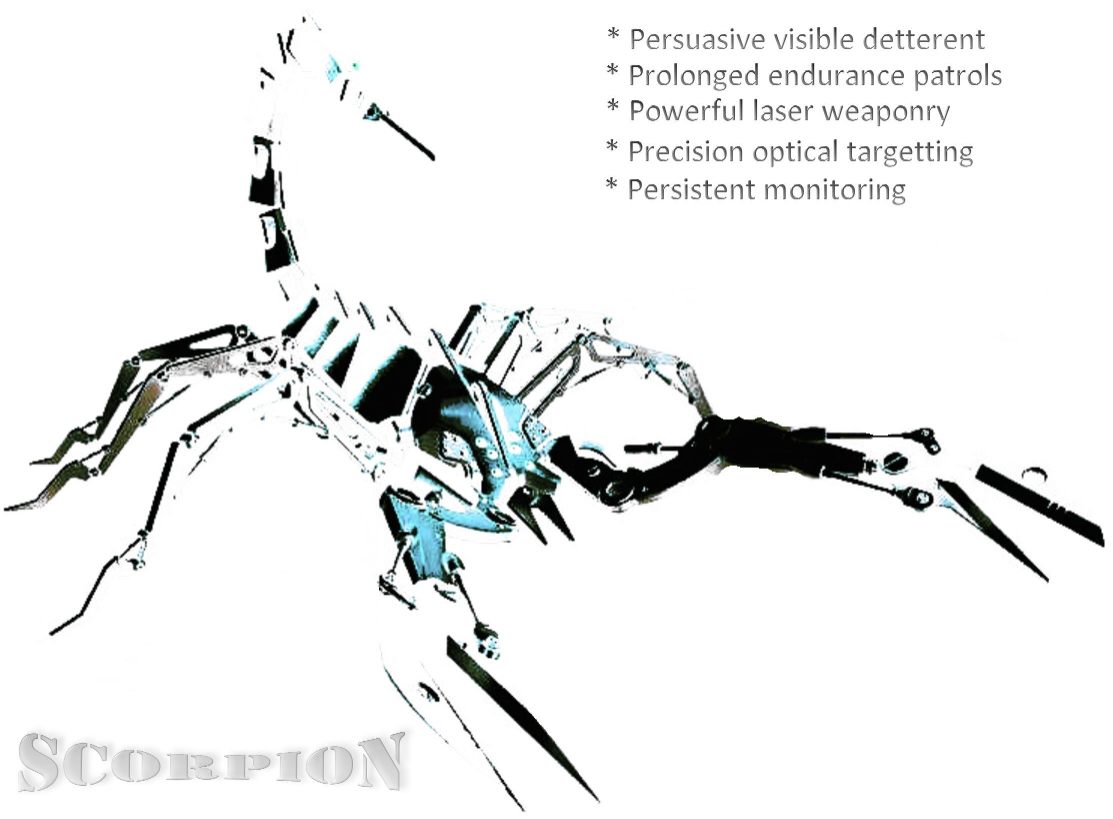
BLUEFISH
DEVELOPMENT PROJECT INDEX A-Z
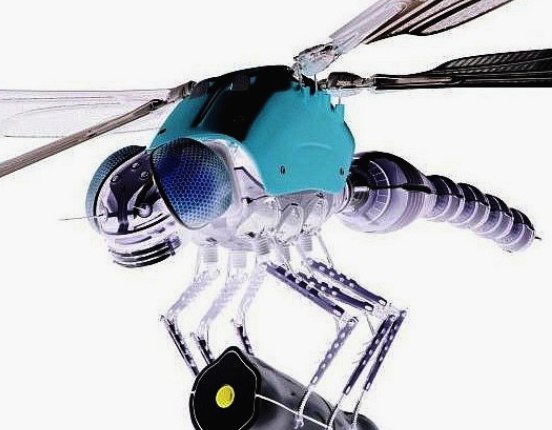
|








